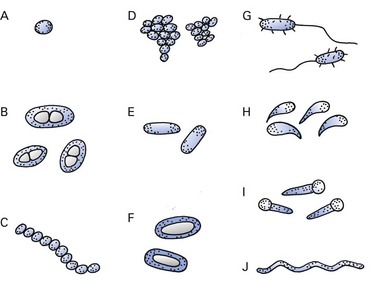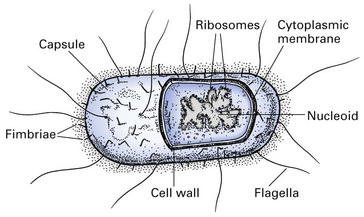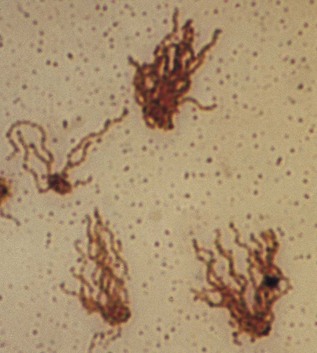Chapter 2 Bacterial structure and taxonomy
Classification of all living beings, including microbes has been attempted by many over centuries (Table 2.1). Traditionally, though they were all classified into two kingdoms, plants and animals, classification was arbitrary and based on morphological and growth characteristics. With the development of novel techniques, the latter classification was expanded to include five kingdoms: monera, protista, plantae, fungi and animalia. However, the current understanding based on their genetic relatedness is that all forms of life fall into three domains: Archaea, Bacteria and Eucarya. The main differences among Archaea, Bacteria and Eucarya are listed in Table 2.2. Note that taken together, Archaea and Bacteria are also known as prokaryotes (see below).
| Bacteria | Archaea | Eucarya |
|---|---|---|
| Organization of the genetic material and replication | ||
| DNA free in the cytoplasm | DNA free in the cytoplasm | DNA is contained with a membrane-bound nucleus. A nucleolus is also present |
| Only one chromosome | Only one chromosome | More than one chromosome. Two copies of each chromosome may be present (diploid) |
| DNA associated with histone-like proteins | DNA associated with histone-like proteins | DNA complexed with histone proteins |
| May contain extrachromosomal elements called plasmids | Plasmids may be found | Plasmids only found in yeast |
| Introns not found in mRNA | Introns not found in most genes | Introns found in all genes |
| Cell division by binary fission – asexual replication only | Reproduce asexually and spores are not found | Cells divide by mitosis |
| Transfer of genetic information occurs by conjugation, transduction and transformation (see Chapter 3) | Processes similar to bacterial conjugation enables exchange of genetic material | Exchange of genetic information occurs during sexual reproduction. Meiosis leads to the production of haploid cells (gametes), which can fuse |
| Cellular organization | ||
| Cytoplasmic membrane contains hopanoids | Membranes contain isoprenes | Cytoplasmic membrane contains sterols |
| Lipopolysaccharides and teichoic acids found | No lipopolysaccharides or teichoic acids found | |
| Energy metabolism associated with the cytoplasmic membrane | Mitochondria present in most cases | |
| Photosynthesis associated with membrane systems and vesicles in cytoplasm | Chloroplasts present in algal and plant cells | |
| Internal membranes, endoplasmic reticulum and Golgi apparatus present associated with protein synthesis and targeting | ||
| Membrane vesicles such as lysosomes and peroxisomes present | ||
| Cytoskeleton of microtubules present | ||
| Flagella consist of one protein, flagellin | Contains flagella that derive energy from proton pumps | Flagella have a complex structure with 9 + 2 microtubular arrangement |
| Ribosomes – 70S | Ribosomes behave more like eucarya when exposed to inhibitors | Ribosomes – 80S (mitochondrial and chloroplast ribosomes are 70S) |
| Peptidoglycan cell walls | Cell walls lack peptidoglycan | Polysaccharide cell walls, where present, are generally either cellulose or chitin |
Morphology
Shape and size
The shape of a bacterium is determined by its rigid cell wall. Bacteria are classified by shape into three basic groups (Fig. 2.1A and B):
Structure
The structure of a typical bacterium is shown in Figure 2.2. Bacteria have a rigid cell wall protecting a fluid protoplast comprising a cytoplasmic membrane and a variety of other components (described below).
Structures external to the cell wall
Flagella
Flagella are whip-like filaments that act as propellers and guide the bacteria towards nutritional and other sources (Fig. 2.3). The filaments are composed of many subunits of a single protein, flagellin. Flagella may be located at one end (monotrichous, a single flagellum; lophotrichous, many flagella) or all over the outer surface (peritrichous). Many bacilli (rods) have flagella, but most cocci do not and are therefore non-motile. Spirochaetes move by using a flagellum-like structure called the axial filament, which wraps around the cell to produce an undulating motion.
Stay updated, free dental videos. Join our Telegram channel

VIDEdental - Online dental courses






